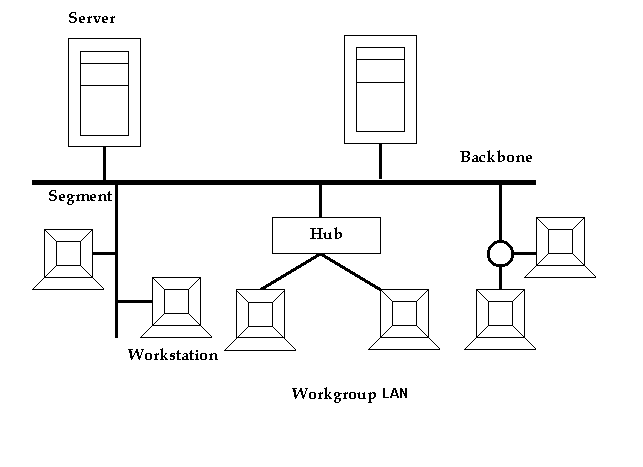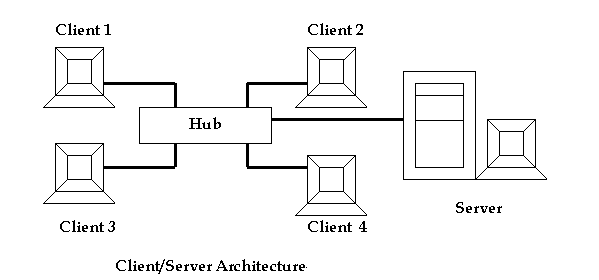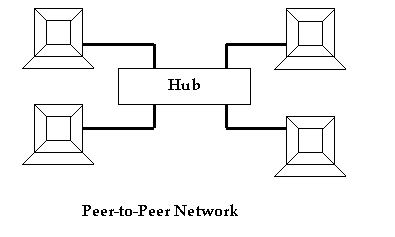1.1 Network Elements:
The term Computer Network is used when two or more computers connected together to share data files, Internet, printer, applications etc. Network can be very simple, such as a small group of computers that are connected to share the resources using a hub (or switch) or they can be very complex covering large geographical areas that use multiple media (like Frame Relay, leased lines, Ethernet etc.) and protocols (like TCP/IP, Novell, AppleTalk).
LAN: LAN is the acronym of Local Area Network, and usually limited to a specific area or location. For example, LAN used in a factory is limited within the boundary of that building. Several small LANs can be combined to make a big LAN using routers, and switches. Users in a small LAN can be grouped into a workgroup. A big LAN may consist of several such small groups of users.

WAN: WAN stands for Wide Area Network. A WAN may be spread across several cities, states, and countries. WANs normally use public switched networks, and telecom lines to communicate across boundaries.
WAN vs LAN:
The Internet is an example of Wide Area Network.
Full-Duplex and Half-Duplex Communications: The term Full-Duplex communication mean simultaneous flow of information in both the directions. The term Half-Duplex mean, communication in only one direction at any given point of time.
Host, Workstation, and Server: Host, Workstation, and Server are the most common network entities used.
Hosts: Host is a generic term representing a network node, and could mean a work station, or a server. It is most commonly used when discussing TCP/IP-related services and functions. Workstations, servers, and any other network device as long as it has one or more IP address it can be considered as hosts.
Workstations:The term network normally refers to any computer that is connected to the network; a workstation is a computer that can request resources. Workstations can be clients, but not all clients are workstations. For example, a printer can request resources from the network, but it is a client and not a workstation.
Servers: A Server provides required resources to its clients. The Server will have a Network Operating System (NOS) that enables the communication between the Server and Clients. Usually, servers are specialized for single purpose such as file server, proxy server etc. Of course, you can configure a single server to do several jobs like authentication, file services, proxy services etc., but that depends on how much load the server can take, and provision for future expansion. The following are the some server examples that are dedicated to a single task:
Client/Server Network: The client/server network uses a Network Operating System (NOS) to manage the entire network from a centralized point, that is the server. The clients make requests to the server and the server responds with the information or access to a resource.

Peer-to-Peer Network:In Peer-to-Peer networks, the connected computers share the resources. If a user of one computer wants to access a resource on another computer, the security check for access rights is the responsibility of the computer holding the resource. With computers becoming more and more powerful in terms of computing resources, peer-to-peer networking is gaining popularity.

Client/Server network vs Peer-to-Peer Network:
The client/server network is more organized and it is easy to find files and resources because they are stored at a centralized location (Server computer). The security of client/server network is high that all the usernames and passwords are stored in the same database and individual users can�t use the server as a workstation. Hence a client/server network gives a better protection against accidental/intentional misuse.
On the other hand, in a Peer-to-Peer network, by spreading the resources across individual workstations, it is possible to use the resources of these machines.
Disclaimer: Simulationexams.com is not affiliated with any certification vendor, and Sim-Ex™ Practice Exams are written independently by SimulationExams.com and not affiliated or authorized by respective certification providers. Sim-Ex™ is a trade mark of SimulationExams.com or entity representing Simulationexams.com.A+™,Network+™,Security+™,Server+™ are trademark of CompTIA® organization.